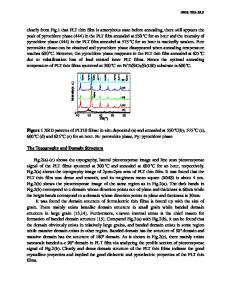Properties of Indium Tin Oxide Films Prepared Using Reactive RF Magnetron Sputtering
- PDF / 359,127 Bytes
- 6 Pages / 420.48 x 639 pts Page_size
- 54 Downloads / 435 Views
PROPERTIES OF INDIUM TIN OXIDE FILMS PREPARED USING REACTIVE RF MAGNETRON SPUTTERING
MADHAV MEHRA AND HOWARD RHODES Electronic Research Laboratories - Photographic Products Group Eastman Kodak Company, Rochester, NY 14650
ABSTRACT The results obtained upon reactively RF sputtering indium - tin oxide (ITO) films are presented. It is found that while the amount of oxygen in the chamber is very critical in determining the properties of the films, it is easy to deposit reproducible films even at low oxygen concentrations when using an oxide target. At concentrations of oxygen below 2 vol% the films deposited exhibit almost metallic conductivities, while retaining an average transparency in the visible range of over 85%. The resistivity of these films increases with the oxygen concentration in the chamber, but the transition is not as sharp as that observed upon sputtering a metal target. These films are found to have very good "figures of merit" and are promising in their use as transparent conductors.
INTRODUCTION Transparent oxide films have received great attention in the recent past due to the unique combination of properties they possess. Being simultaneously transparent and conducting, they can be used as electrodes in solar cell applications, in television camera vidicons, and in liquid crystal displays. Each application necessitates a tradeoff between the maximum conductivity and the maximum transparency that is attainable in the conductor. While, for instance, in vidicon tubes the transparency is very important (especially in the blue), in liquid crystal applications transparency is often compromised in favor of the high conductivities required in the fine, lithographically etched, patterns. The techniques used to make these films have also been tailored to the particular applications in mind. They include, among others, chemical vapor deposition (CVD), sputtering, evaporation, and spray pyrolisis Many comprehensive reviews which describe these processes in detail and also discuss the properties of the films have appeared in the literature[1,2]. This paper presents the results obtained from RF magnetron sputtering of films of indium - tin oxide (ITO).
EXPERIMENTAL PROCEDURES All the samples reported in this study were prepared by RF sputtering a target of In 0 - 9 mol% SnO2 in a mixture of argon and oxygen. The target was bought from Raeerials Research Corporation and the sputtering was carried out in an MRC-603 system. The oxygen concentration in the chamber was varied between zero (nominally) and 10 vol% using an MKS 294 mass flow controller system. The sputtering pressure could be maintained at a constant value using an MKS 190M capacitance manometer. The thickness of the deposited layers was measured using a Tencor profilometer, and the sheet resistivity was characterized using a four point probe. The spectrophotometry data were collected between 200 and 900 nm using a Cary 219 instrument. Since there was significant absorption in the films at lower wavelengths (about 30%), the simple assumptions usual
Data Loading...










